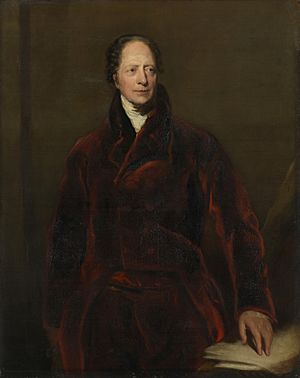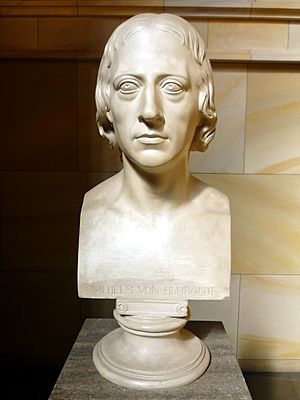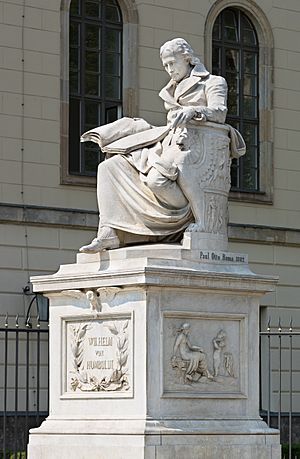Wilhelm von Humboldt facts for kids
Quick facts for kids
Wilhelm von Humboldt
|
|
|---|---|

Portrait by Thomas Lawrence
|
|
| Born | 22 June 1767 |
| Died | 8 April 1835 (aged 67) Tegel, Prussia
|
| Nationality | Prussian |
| Education | University of Frankfurt (Oder) (no degree) University of Göttingen (no degree) |
| Spouse(s) | Caroline von Dacheröden |
| Era | 19th-century philosophy |
| Region | Western philosophy |
| School | Berlin Romanticism Romantic linguistics Classical liberalism |
| Institutions | University of Berlin |
|
Main interests
|
Philosophy of language |
|
Notable ideas
|
Language as a rule-governed system Humboldtian model of higher education |
|
Influences
|
|
|
Influenced
|
|
| Signature | |
 |
|
Friedrich Wilhelm Christian Karl Ferdinand von Humboldt (born June 22, 1767 – died April 8, 1835) was an important person from Prussia. He was a philosopher (a deep thinker), a linguist (someone who studies language), a government official, and a diplomat. He also helped create the Humboldt University of Berlin, which was named after him and his younger brother, Alexander von Humboldt.
Wilhelm von Humboldt is best known as a linguist who made big contributions to how we think about language and education. He believed that education should help people reach their full potential. It was not just about teaching old ideas for a specific job. He designed the Humboldtian education ideal, which became a model for public schools in Prussia, the United States, and Japan. He became a member of the American Philosophical Society in 1822.
Contents
Wilhelm von Humboldt's Life
Humboldt was born in Potsdam, a city in Prussia. He passed away in Tegel, which was also in Prussia.
In June 1791, he married Caroline von Dacheröden. They had eight children together. Five of their children, including Gabriele von Humboldt, lived to be adults.
Humboldt as a Philosopher
Humboldt was a significant philosopher. He wrote a book called The Limits of State Action between 1791 and 1792. This book was a strong argument for individual freedoms during the Age of Enlightenment. It was not published until 1850, after his death.
His ideas greatly influenced John Stuart Mill's famous essay On Liberty. Through Mill, Humboldt's thoughts became well-known in English-speaking countries. Humboldt described an early version of what Mill later called the "harm principle." This idea suggests that people should be free to do what they want, as long as it does not harm others.
A part of his book about education was published in 1792. In this publication, Humboldt joined the discussion about how national education should be organized after the French Revolution.
Educational Changes by Humboldt

Wilhelm von Humboldt was taught at home when he was young. He did not finish his university studies at Frankfurt (Oder) or Göttingen. Despite this, he became one of the most important officials in German education.
Humboldt wanted to be the Minister of Education, but he did not get that job. The Prussian King asked him to leave Rome in 1809 to lead the education department. Humboldt took several weeks to reply because he preferred to stay at the embassy in Rome. His wife did not return to Prussia with him. They met again when Humboldt left his education job and became the head of the Embassy in Vienna.
Humboldt created a standard system for public education. This system went from basic schools all the way up to secondary education. He also founded the Berlin University. He made sure that state exams and inspections were the same everywhere. He also created a special department to manage and design school lessons, textbooks, and learning tools.
Humboldt's education model was more than just job training. He wrote to the Prussian king, saying that everyone needs general knowledge and a good mind and character. He believed that people could not be good workers unless they were also good, honest, and well-informed citizens. He thought that if this basic education was provided, job skills could be learned easily later. This would also allow people to change jobs if they wanted to.
Humboldt as a Diplomat
Between 1802 and 1819, Humboldt was a very successful diplomat. He served as the Prussian minister in Rome starting in 1802. From 1812, he was the ambassador in Vienna during the end of the Napoleonic Wars. At the congress of Prague in 1813, he helped convince Austria to join Prussia and Russia against Napoleon.
He also signed the peace treaty in Paris and the treaty between Prussia and Saxony in 1815. He was present at the congress in Aachen in 1818. However, the Prussian government became more strict, which made him leave political life in 1819. After that, he focused only on his studies and writing.
Humboldt's Work with Languages

Wilhelm von Humboldt was a skilled linguist. He studied the Basque language and translated ancient Greek works by Pindar and Aeschylus into German.
Humboldt's work on the Basque language had a lasting impact. He visited the Basque country twice. This led to his book, Researches into the Early Inhabitants of Spain by the help of the Basque language (1821). In this book, Humboldt tried to show that people speaking languages similar to modern Basque once lived across Spain, southern France, and the Balearic Islands. He thought these people were the "Iberians" mentioned by ancient writers. He also guessed they were connected to the Berbers of North Africa. While modern language studies and archaeology have updated some of his ideas, his work was groundbreaking.
Humboldt was working on his biggest project about the ancient Kawi language of Java when he died. However, its introduction was published in 1836. This essay, called The Heterogeneity of Language and its Influence on the Intellectual Development of Mankind, talked about the philosophy of speech.
It explained that a language's structure shows how its speakers think and understand the world. Languages differ because the people who use them differ. Sounds only become words when they are given meaning, and this meaning comes from a community's thoughts. Humboldt called the "inner form" of a language the way it shows relationships between parts of a sentence. This reflects how a group of people sees the world around them.
Noam Chomsky, a famous modern linguist, often quotes Humboldt's idea that language "makes infinite use of finite means." This means we can create an endless number of sentences using a limited set of grammar rules.
More recently, Humboldt has also been seen as one of the first to suggest the idea of linguistic relativity. This idea, also known as the Sapir-Whorf hypothesis, was developed by linguists Edward Sapir and Benjamin Lee Whorf a century later. It suggests that the language we speak can influence how we think about the world.
Humboldt's ideas are still studied today. Scholars like Jürgen Trabant and Anna Wierzbicka continue to explore his concepts of language and how it shapes our understanding of the world.
See also
In Spanish: Wilhelm von Humboldt para niños

